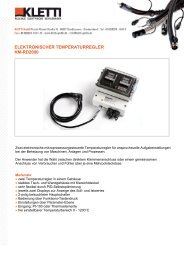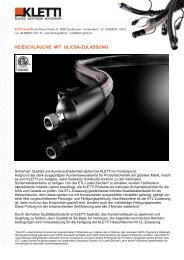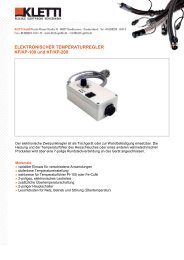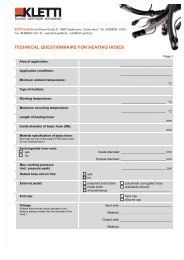OPERATING INSTRUCTION FOR HEATING HOSES - Kletti GmbH
OPERATING INSTRUCTION FOR HEATING HOSES - Kletti GmbH
OPERATING INSTRUCTION FOR HEATING HOSES - Kletti GmbH
Create successful ePaper yourself
Turn your PDF publications into a flip-book with our unique Google optimized e-Paper software.
COMMISSIONING<br />
Before putting the heating hose into operation, observe the following:<br />
» Specifications on type plate must coincide with your order data<br />
» Use only temperature controls compatible with the type of sensor in the heating hose.<br />
» Ensure that the line voltage coincides with the voltage specified on the type plate.<br />
» Ensure that the nominal power for the heating hose does not exceed the maximum power output of<br />
the connected temperature control or power output from the equipment (resistive load).<br />
» Never operate the heating hose without temperature sensor (connected to temperature control),<br />
because otherwise it heats up without control and exceeds the maximum operating temperature<br />
which can lead to damage to the heating hose and your equipment.<br />
» Provide for a protective system to protect the line against excessive temperature in the event of overload.<br />
Line protection according to VDE 0721, Part 1, Section 19, must ensure that the nominal value of the fuse<br />
is matched to the specific load and must be connected in series in front of the heating hose (including control).<br />
However, the max. fuse rating must not exceed 16A. We recommend using a conductor with a cross section of<br />
at least 1.5mm²<br />
» If the heating hose is suspended or fastened with clamps, ensure that the outer diameter of the heating hose<br />
is not reduced by more than 10%.<br />
» Ensure that connection fittings are not under tension, under any circumstances.<br />
» It is necessary for the heating hose to reach its operating temperature before it is subjected to<br />
your operating pressure, because the medium could still be rigid at the fittings.<br />
» The time required to heat up the heating hose to operating temperature is approx. 15-30 minutes, as<br />
a rule. As soon as the hose reaches his operating temperature the fittings have to be tightening<br />
again. When starting up the system for the first time or restarting; ensure that the medium in the<br />
heating hose has reached its processing temperature to avoid damage to the inner hose.<br />
» Observe minimum bending radiuses! (see page 5).<br />
» Kinks and high torsion loads lead to destruction of the heating hose.<br />
» Observe placing instructions (see pages 6 to 8)<br />
» The resistance of the flexible heating hoses to pressure changes at various operating temperatures<br />
(see list on page 5). In the range up to 250°C, the pressure resistance can be specified, however,<br />
this decreases down to 0 bars at temperatures above 250°C. The maximum operating pressure should<br />
be calculated with a corresponding correction factor, depending on the maximum operating temperature.<br />
Also observe pressure surges. These can be very high and are not indicated by normal pressure gauges.<br />
Never exceed the operating pressure!<br />
» Hoses and PTFE tubing up to NW 8 have been tested for their suitability for use with vacuum down to<br />
8 mbar at temperatures up to 250°C.<br />
5









